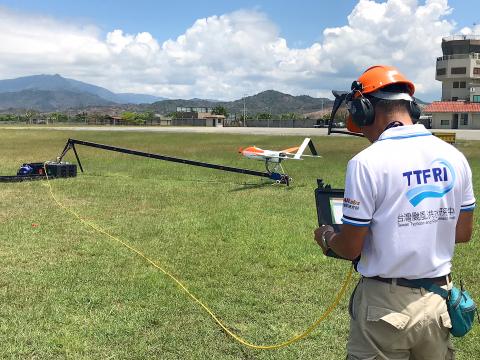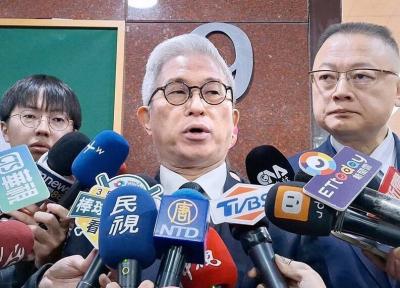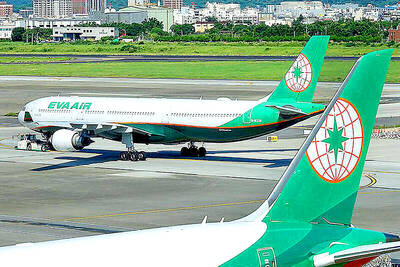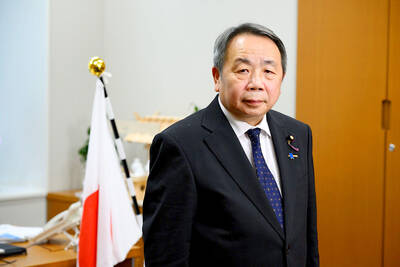While local researchers, institutes and technology enthusiasts are keen to explore the applications that uncrewed aerial vehicles (UAVs) offer, many are hampered by a lack of funding, space for conducting experiments and regulations to monitor the industry’s development.
The Taiwan Typhoon and Flood Research Institute, a subsidiary agency of the National Applied Research Laboratories, is planning to use an Australian-made drone that can fly straight into the eye of a storm to collect data.
The program is a collaboration between the institute, the Central Weather Bureau, National Taiwan University (NTU) and other agencies.

Photo provided by Taiwan Typhoon and Flood Research Institute
Since 2003, Aerospace Industrial Development Corp airplanes have been used to gather data on typhoons under the Typhoon Hunting Program and the Dropwindsonde Observations for Typhoon Surveillance Near the Taiwan Region, institute deputy director-general Feng Lei (鳳雷) said.
The Typhoon Hunting program can elevate the precision of a forecast by about 6 percent, but storm forecasting has hit a bottleneck, institute assistant technologist Jung Chi-june (鍾吉俊) said.
“We can grasp the path of a typhoon, but how strong its structure would be and how much damage it would cause on land need more study,” Chung said.
That is why drones are needed to get deeper into a storm, he said.
While drones were deployed to measure Typhoon Hato last year and Typhoon Nepartak in 2016, they could only hover on the storms’ edges due to technical issues, Chung said.
However, the institute is hoping to make better progress this year. It is to conduct trial runs of its drone — the Aerosonde MK 4.7 — on the campus of National Ilan University from March 5 to March 9.
If successful, the drone would fly straight into a storm this summer, Feng said.
The drone was made by the Australian company Aerosonde Pty and equipped with a weather observation sensor, a satellite communication system, and a self-driving and self-landing system, the institute said, adding that it cost about NT$4 million (US$136,323).
Progress in the local UAV industry has been hampered by the lack of technology to manufacture drone engines and space for conducting trial runs, Feng said, adding that the institute had to drop several plans to use drones for other monitoring purposes due to a lack of funds.
The nation has technicians capable of producing such engines, said Lin Po-hsiung (林博雄), institute consultant and an associate professor at NTU’s Department of Atmospheric Sciences.
For example, Cheng Tsung-yi (鄭宗毅), a Taiwanese technician who used to work for Aerosonde, is experienced in refitting drone engines, Lin said, adding that there are many other Taiwanese who have pertinent skills.
Having locally made drones would enable researchers to install additional devices they need, but the nation lacks a resourceful coordinator who can pool the necessary experts and funding, Lin said.
Seeking funding is difficult because the government has a limited budget, while most businesses do not want to invest in aircraft that might break down after only one flight, he said.
The nation’s restricted air space is another barrier to drone development, Lin said.
While many believe bolder experiments can lead to universal good, when it comes to air space, most countries become more conservative and tend to defend their territorial sovereignty first, Lin said.
“Many people have an indescribable fear of unmanned vehicles,” partly because they are afraid of uncertainty or that drones might be detectors or weapons, he said.
Despite these problems, developing drone technology has become an irresistible trend across the globe, which has an estimated market value of up to US$127.3 billion, accounting firm PricewaterhouseCoopers said in its 2016 report on the commercial applications of drone technology.
Asked how the government can foster the development of drone applications, Lin said that UAVs need proper regulation, but separate regulations for experimental drones are also needed.
Many experiments with drones have been undertaken in gray areas of the law, he said.
“Many aircraft lovers spend their own money conducting small-scale research and development, while big corporations are still looking on, waiting for the proper moment to enter the market,” said A3 Fun consultant Linder Lin, who also works as a pilot for China Airlines.
The nation’s current policies are unfavorable to the development of drones, with most of the research and development budget going to military agencies, he said.
Meanwhile, Chinese companies are taking giant leaps in manufacturing drones, he said.
“If Taiwanese cannot compete with others in technique, they can focus on exploring drone applications,” he said, urging the government to loosen aviation regulations to allow for more experiments.
On Feb. 7, the Ministry of Science and Technology said it had sent a draft bill on experimental drones to the Executive Yuan and expects it to be forwarded for review in the upcoming legislative session.
People who intend to conduct experiments using drones can file an application with the Ministry of Transportation and Communications, which would be responsible for granting approval and regulating their traffic, the draft bill said.
Applicants who have obtained approvals from the ministry would be exempt from the Civil Aviation Act (民用航空法), the Highway Act (公路法), the Ships Act (船舶法) and the Road Traffic Management and Penalty Act (道路交通管理處罰條例) when conducting experiments, the bill said.
However, which ministry should be tasked with stimulating drone-related research and applications — instead of passively reviewing applications — and which government agency would help negotiate international arguments following the operation of self-driving aircraft and vessels are issues that still need to be addressed.

A strong continental cold air mass is to bring pollutants to Taiwan from tomorrow, the Ministry of Environment said today, as it issued an “orange” air quality alert for most of the country. All of Taiwan except for Hualien and Taitung counties is to be under an “orange” air quality alert tomorrow, indicating air quality that is unhealthy for sensitive groups. In China, areas from Shandong to Shanghai have been enveloped in haze since Saturday, the ministry said in a news release. Yesterday, hourly concentrations of PM2.5 in these areas ranged from 65 to 160 micrograms per cubic meter (mg/m³), and pollutants were

Taiwan’s armed forces have established response protocols for a wide range of sudden contingencies, including the “Wan Chun Plan” to protect the head of state, the Ministry of Defense (MND) said today. After US President Donald Trump on Saturday launched a series of airstrikes in Venezuela and kidnapped Venezuelan President Nicolas Maduro, concerns have been raised as to whether China would launch a similar “decapitation strike” on Taiwan. The armed forces regularly coordinate with relevant agencies and practice drills to ensure preparedness for a wide range of scenarios, Vice Minister of National Defense Hsu Szu-chien (徐斯儉) told reporters before a

EVA Airways on Saturday said that it had suspended a pilot and opened an investigation after he allegedly lost his temper and punched the first officer several times as their plane was taxiing before takeoff at Los Angeles International Airport. According to a report published on Thursday by The Reporter, the incident occurred after the flight’s Malaysian first officer tried to warn the Taiwanese pilot, surnamed Wen (文), that he was taxiing faster than the speed limit of 30 knots (55.6kph). After alerting the pilot several times without response, the first officer manually applied the brakes in accordance with standard operating

Japanese Councilor Hei Seki (石平) on Wednesday said that he plans to visit Taiwan, saying that would “prove that Taiwan is an independent country and does not belong to China.” Seki, a member of the Japan Innovation Party, was born in Chengdu in China’s Sichuan Province and became a naturalized Japanese in 2007. He was elected to the House of Concilors last year. His views on the Chinese Communist Party (CCP) — espoused in a series of books on politics and history — prompted Beijing to sanction him, including barring Seki from traveling to China. Seki wrote on X that he intends